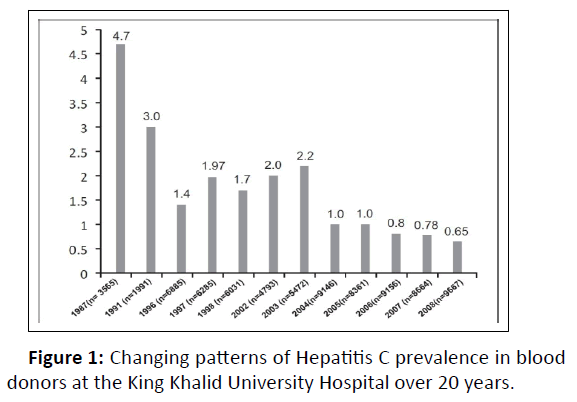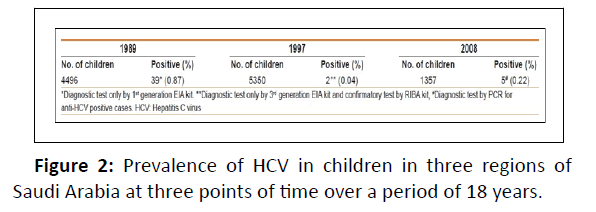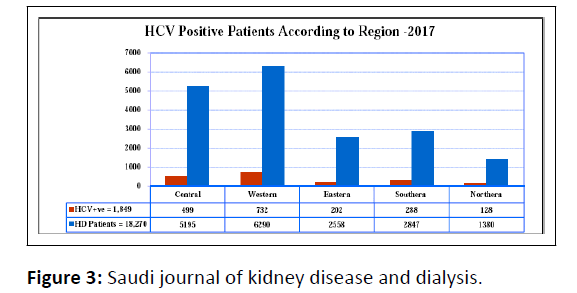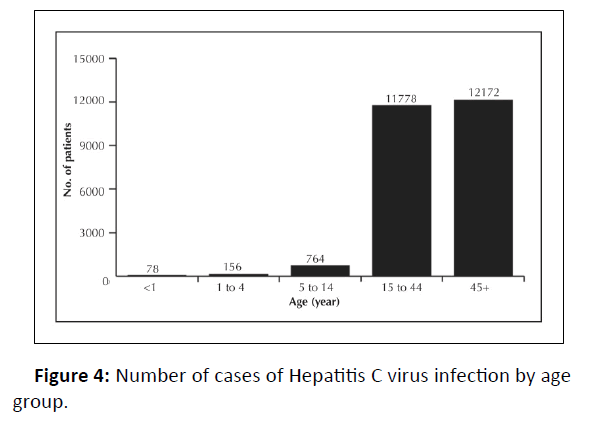Epidemiology of HCV in Saudi Arabia and it's Burden on the Health Care System
Yara Muallem*
Department of Medicine, Osh State University, Osh, Kyrgyzstan
- *Corresponding Author:
- Yara Muallem
Department of Medicine, Osh State University, Osh,
Kyrgyzstan,
E-mail: yaramouallem@gmail.com
Received date: November 23, 2022, Manuscript No.IPMCRS-22-15321; Editor assigned date: November 25, 2022, PreQC No.IPMCRS-22-15321 (PQ); Reviewed date: December 06, 2022, QC No.IPMCRS-22-15321; Revised date: December 16, 2022; Manuscript No. IPMCRS-22-15321(R); Published date: December 23, 2022, DOI: 10.36648/2471-8041.8.12.257
Citation: Muallem Y (2022) Epidemiology of HCV in Saudi Arabia and it’s Burden on the Health Care System. Med Case Rep Vol.8 No.12:257.
Abstract
Currently, 170 million people worldwide are infected with the chronic form of the Hepatitis C Virus (HCV). It represents a global epidemic. Although the prevalence of HCV infection has significantly decreased in Saudi Arabia, these viral illnesses still cause significant morbidity and mortality and place a heavy cost on the nation's healthcare system.
Keywords
Epidemiology; Saudi Arabia; Hepatitis C; Prevalence
Introduction
Hepatitis C epidemiology in Saudi Arabia
Studies on HCV seroprevalence have been used extensively in descriptions of HCV epidemiology in the KSA. These research projects often have a cross-sectional design and target certain demographics, such blood donors. Although population-based studies are much more valuable, they are generally not practical, particularly in KSA. Despite reported declines in HCV prevalence over the past ten years, the condition still poses a serious threat to the nation's public health, particularly for hemodialysis patients and intravenous drug users. As of this writing, there hasn't been a significant community-based study that provides information on the true prevalence of HCV in the KSA [1].
According to prevalence data gathered from Saudi blood donor screening facilities, HCV infection rates range from 0.4%to 1.1%.HCV prevalence rates decreased from 0.58% in 1996 to 0.08% in 2006, according to statistics from the blood bank of King Khalid University Hospital in Riyadh.According to a WHO summary report, there have been 437,292 confirmed cases of HCV infection among residents of the KSA, translating to an estimated prevalence of 1.8% (Figure 1).
A significant cross-community investigation on the prevalence of HCV in Saudi children included a population-based survey of 4496 kids from various locations of the nation (aged 1-10). In our HBV vaccination follow-up studies, we also tested children for HCV serology using a more dependable third-generation ELISA test in conjunction with a Recombinant Immunoblot Assay (RIBA) for confirmation. Of these kids, 39 (0.90%) tested positive for HCV antibodies using a first-generation Enzyme-Linked Immunosorbent Assay (ELISA) kit, which is known to produce false positives [2]. According to unpublished data, the prevalence of HCV infection in Saudi children increased marginally from 0.04% for children aged 1 to 12 in 1997 to 0.22% for teenagers aged 16 to 18 in 2008, echoing global increases in HCV prevalence associated with aging populations (Figure 2).
Relatively, the epidemiology literature from Saudi Arabia reports HCV incidence more thoroughly than it does general prevalence rates. However, even in nations with well-established surveillance systems, acute disease reporting systems may significantly underestimate the prevalence of HCV infection [3]. A recent study that analyzed the number of adult HCV infections in the KSA over the course of 11 years of monitoring (1994– 2005) revealed regional diversity in incidence and an overall average of 124 infections per 100,000 individuals.
Investigation's ability to generalize to the full Saudi population is constrained by its passive reporting style. Since the patient identities used in the data collection are not very reliable, these data are also likely to contain duplicates and representation from numerous non-Saudi people. Recently, a more thorough investigation showing incidence patterns of viral Hepatitis seropositivity among people treated at National Guard Health Affairs (NGHA) facilities in the central, Eastern and Western parts of the nation was released [4]. 14,000 seropositive cases of viral Hepatitis were reported to this monitoring system between 2000 and 2007. HBV had the highest yearly incidence of seropositivity on average (104.6), followed by HCV, while HAV had the lowest incidence of seropositivity (per 100,000 treated population). Saudis had reduced HCV incidence compared to non-Saudis but greater HBV and HAV incidence. Throughout the whole 8-year period of observation, the incidence of viral Hepatitis decreased steadily by 20%–30% for all three categories [5].
From 1995 to 2006, the number of HCV cases reported to the MOH per region varied significantly between the 13 administrative provinces of Saudi Arabia, with Jizan (0.016%) having the lowest prevalence (per capita) and Al-Baha and Jeddah having the highest. These findings are in line with earlier research from the KSA. One study of 528 blood donors in the Jeddah area indicated a 1.7% prevalence of HCV infection, while another of 557,815 Saudi citizens in the Riyadh province discovered a 1.1% prevalence of anti-HCV in adults (Figure 3).
One explanation for the difference in prevalence rates between adults and children is the decrease in transmissions acquired through transfusion-related procedures as a result of stricter HCV testing requirements adopted nationally two decades ago. Additionally, safer blood transfusion procedures, surgical, dental and procedural practices, general improvements in sanitation and a higher standard of living, and screening of all expatriate populations upon entry into the country may all be linked to general declines in both incidence and prevalence of HCV in the nation (Figure 4).
The most common genotypes in the nation, according to large investigations conducted over a single decade from 1995 to 2004, were genotype-4, followed by genotypes 1a and 1b. While genotypes 3 and 6 continue to be incredibly rare, other genotypes, such 2a/2b, arose from the Eastern Province and genotype-5 from the Western Province [6].
Literature Review
Prevalence in special populations
Hepatitis C is common among people, but it also poses a serious health risk to a number of other particular populations. For instance, the most prevalent cause of liver damage in dialysis patients is Hepatitis C. The fact that those on maintenance Hemodialysis (HD) have a lower level of immunity than the general population and require frequent blood transfusions puts them at a higher risk of getting HCV. Hemodialysis is still the most frequently utilized type of renal replacement therapy in the KSA. In addition, the number of patients undergoing HD treatment in the nation has been rising dramatically, from roughly 2085 patients in 1990 to more than 8000 patients in 2006, spread among 140 dialysis units [7].
Additionally, the country saw a rise in HCV endemicity from 41% to 55% in the mid-1990s, which coincided with the abrupt expansion of HD services, including the introduction of new HD machines and additional HD facilities. In addition to HD patients, intravenous drug users are another group with a high HCV risk in the KSA and their numbers are growing, as they are globally. In this nation, both injectable narcotics like heroin and cocaine as well as non-injectable drugs like cannabis and stimulants similar to amphetamines are overused. The estimated heroin use rate in Saudi Arabia among adults over 15 years of age was 0.01% in 2000 between 1996 and 2001, admissions to detoxification facilities in Riyadh, Jeddah, Dammam, and Qassim varied from 4740 to 6650 people annually. An analysis of 344 Saudi injecting drug users conducted recently revealed a 38% prevalence of viral infection. It was discovered that genotype-1b was the most common HCV genotype.
HCV burden on national health
Due to a severe scarcity of recent literature, it is significantly more challenging to estimate the prevalence of HCV in Saudi Arabia compared to HBV. Given the information discussed in this review, it is reasonable to assume that the prevalence of HCV in the Saudi population as a whole ranges from 1%-3%; however, given that the majority of the population is younger (where the prevalence rate is lower); an overall general prevalence of about 1% may be more realistic. This would result in an estimated patient population of almost 200,000, many of whom may still be going undiagnosed [8].
Given the limitations of the reported studies and the speculative nature of these assumptions, we can reasonably predict that 20% of all chronic viral Hepatitis patients (200,000 with Hepatitis C) will eventually develop cirrhosis within the next 20 years. This will place a significant strain on the Saudi healthcare system as 88,000 of these patients will require expensive and advanced medical treatment. We can further anticipate that 8800 decompensated cirrhotic individuals per year will become potential candidates for liver transplantation given an estimated 10% annual probability of de-compensation (without therapy). Furthermore, cirrhotic patients have a 1%-4% yearly incidence rate of developing Hepatocellular Carcinoma (HCC), which equates to about 1500 new cases of HCC each year.
Conclusion
Over the past 30 years, there has been a gradual drop in HCV prevalence in Saudi Arabia. Better living circumstances, widespread blood bank screening and improved awareness of safe clinical and social procedures may be to credit for this. The sub-population of injecting drug users is anticipated to rise and eventually become the highest risk group for HCV infection. There are still noticeable differences in prevalence rates between different parts of the country for HCV. Despite the drop in prevalence, chronic liver disease will continue to be a major burden on Saudi Arabia's healthcare system for years to come. Additional difficulties are anticipated as a large number of patients that have not yet been diagnosed with the disease start to emerge at an advanced stage. In the next 20 years to 40 years, there will be an increase in the number of patients with liver cirrhosis who experience complications and need advanced care. An project that focuses on early identification, accurate and prompt assessment and efficient treatment represents an important objective. To achieve this aim, a more concerted national effort is needed, one that involves expanding access to liver transplants for people with end-stage liver disease.
Because it is not feasible to directly detect the incidence of HCV, researchers in the KSA must rely on mathematical models to predict trends in incidence. However, as these models rely on the presumption that current prevalence reflects the cumulative risk of contracting an infection, such endeavors can only take place in situations when population-based age-specific seroprevalence data are available. The performance of extensive epidemiological, community-based studies on HCV prevalence in the non-vaccinated older populations, along with an in-depth analysis of the risk factors associated with both HCV acquisitions in the modern era will close the remaining gaps in the viral hepatitis epidemiology story of the KSA.
References
- Shobokshi OA, Serebour FE, Al-Drees AZ, Mitwalli AH, Qahtani A, et al. (2003) Hepatitis C virus seroprevalence rate among Saudis. Saudi Med J 24: S81-6.
[Crossref], [Google Scholar], [Indexed]
- Mehdi SR, Pophali A, Al-Abdul Rahim KA (2000) Prevalence of Hepatitis B and C and blood donors. Saudi Med J 21: 942-944.
[Crossref], [Google Scholar], [Indexed]
- Al-Faleh FZ, Ayoola EA, Al-Jeffry M, Al-Rashed R, Al-Mofarreh M, et al. (1991) Prevalence of antibody to Hepatitis C virus among Saudi Arabian children: A community-based study. Hepatology 14: 215-8.
[Crossref], [Google Scholar], [Indexed]
- Madani TA (2007) Hepatitis C virus infections reported in Saudi Arabia over 11 years of surveillance. Ann Saudi Med 27: 191-4.
[Crossref], [Google Scholar], [Indexed]
- Memish ZA, Knawy BA, El-Saed A (2010) Incidence trends of viral Hepatitis A, B, and C seropositivity over eight years of surveillance in Saudi Arabia. Int J Infect Dis 14: e115-20.
[Crossref], [Google Scholar], [Indexed]
- Karkar A (2007) Hepatitis C in dialysis units: The Saudi experience. Hemodial Int 11: 354-367.
[Crossref], [Google Scholar], [Indexed]
- Shobokshi OA, Serebour FE, Skakni L, Al-Saffy YH, Ahdal MN (1999) Hepatitis C genotypes and subtypes in Saudi Arabia. J Med Virol 58: 44-48.
[Crossref], [Google Scholar], [Indexed]
- Karkar A, Abdelrahman M, Ghacha R, Malik TQ (2006) Prevention of viral transmission in HD units: The value of isolation. Saudi J Kidney Dis Transpl 17: 183-188.
[Crossref], [Google Scholar], [Indexed]

Open Access Journals
- Aquaculture & Veterinary Science
- Chemistry & Chemical Sciences
- Clinical Sciences
- Engineering
- General Science
- Genetics & Molecular Biology
- Health Care & Nursing
- Immunology & Microbiology
- Materials Science
- Mathematics & Physics
- Medical Sciences
- Neurology & Psychiatry
- Oncology & Cancer Science
- Pharmaceutical Sciences




